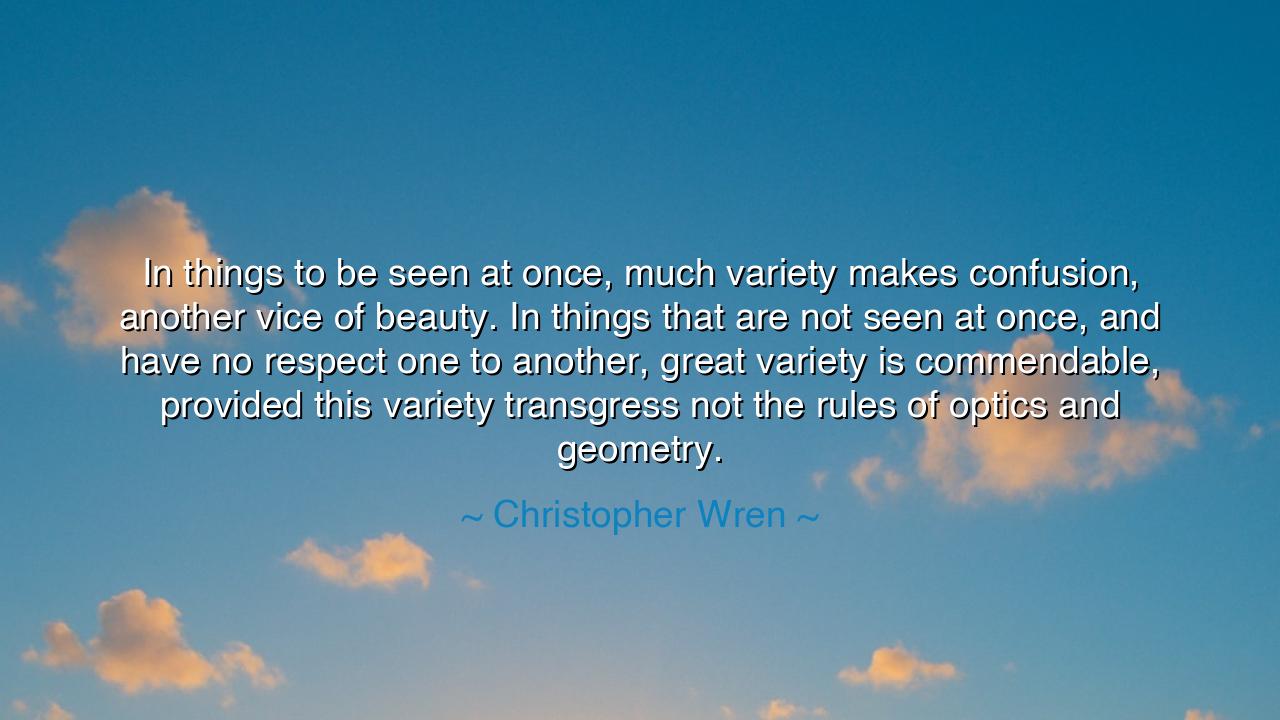
In things to be seen at once, much variety makes confusion
In things to be seen at once, much variety makes confusion, another vice of beauty. In things that are not seen at once, and have no respect one to another, great variety is commendable, provided this variety transgress not the rules of optics and geometry.






"In things to be seen at once, much variety makes confusion, another vice of beauty. In things that are not seen at once, and have no respect one to another, great variety is commendable, provided this variety transgress not the rules of optics and geometry." — Christopher Wren
Hear now the wisdom of Christopher Wren, the great architect of London, whose hands restored a city from ashes and whose mind bridged art and science in perfect harmony. In these words, he speaks not only of architecture, but of life itself — of balance, clarity, and the delicate law that governs both form and thought. When he says, “In things to be seen at once, much variety makes confusion,” he warns that beauty, though it delights in diversity, must be ordered by reason. For even the most splendid elements, if they are not arranged with harmony, will dissolve into chaos. Beauty without balance becomes noise, and abundance without structure breeds disorder.
Wren’s words were born in the age of rebuilding — in the seventeenth century, when London lay in ruins after the Great Fire of 1666. Tasked with restoring the city, he faced a challenge that was both artistic and moral. He saw that a city, like a soul, must be unified in design, or it will lose its coherence. The streets of old London had been a tangle of narrow alleys and crooked facades, where chaos reigned both in sight and in spirit. From this, Wren learned what his quote teaches: that in things to be seen at once — whether a building, a painting, or a human life — too much variety confuses the eye and weakens the whole. The eye, like the mind, craves order, proportion, and clarity.
And yet, he does not condemn variety itself. On the contrary, he praises it — but only in the right measure and place. He writes, “In things that are not seen at once… great variety is commendable.” Here lies a deeper truth: when the parts are separate, when they belong to different scenes, ages, or purposes, variety becomes not a curse but a blessing. For diversity, when guided by principle, enriches creation rather than confusing it. A forest of many trees is beautiful because each has its place; a symphony of many instruments is powerful because each follows the same rhythm. Wren thus teaches that variety without unity is chaos, but unity without variety is monotony.
This wisdom echoes through the ages. The ancient Greeks knew it when they inscribed upon their temples the law of symmetry — that each column, though distinct, must align with its brethren to uphold the whole. The sculptor Phidias used differing poses and features in his friezes, yet every figure obeyed the geometry of the scene. In this, the ancients and Wren alike obeyed the laws of optics and geometry — not merely mathematical rules, but the divine proportions that mirror the order of the cosmos. To transgress them is to invite disharmony; to honor them is to reflect the mind of the Creator.
Consider, for a moment, St. Paul’s Cathedral, Wren’s own masterpiece. To behold it from afar is to witness unity — the great dome rising in serene perfection, the lines converging toward the heavens. Yet to walk within its walls is to discover variety beyond measure: arches of differing form, chapels adorned with diverse carvings, paintings that tell a hundred stories. Each detail stands unique, yet all serve one purpose — to draw the eye upward, toward light and eternity. Here, Wren embodied his own teaching: harmony in the whole, freedom in the parts. Thus, his architecture became not just stone and mortar, but a philosophy made visible.
But let us not confine his teaching to art alone. For life, too, demands the same balance. In our daily affairs, if we chase too many desires at once, our spirit grows scattered and confused. Variety without direction leads to exhaustion, and beauty becomes burden. Yet if we live too rigidly, denying the richness of experience, our hearts grow narrow and lifeless. The wise soul must, like the master architect, distinguish between what must be seen together — the vision that defines life’s purpose — and what may vary without harm — the details that color it. In all things, we must remain faithful to our own geometry of the soul.
So, O children of the future, remember this teaching: seek harmony in the whole and diversity in the parts. When you build — be it a home, a work, or a life — let clarity rule the center, and variety dance at the edges. Respect the rules of optics and geometry, not merely of the eye but of the spirit: the laws of proportion, patience, and purpose. For beauty is not born of abundance alone, but of balance, where the many serve the one, and the one gives meaning to the many.
Thus spoke Christopher Wren — architect not only of cities, but of wisdom. His words remind us that creation, whether of stone or of spirit, must follow the divine law: order is the vessel of beauty, and beauty the light of truth.






AAdministratorAdministrator
Welcome, honored guests. Please leave a comment, we will respond soon